东华理工大学812分析化学(含仪器分析)2018年考研初试真题
- 格式:pdf
- 大小:309.97 KB
- 文档页数:6
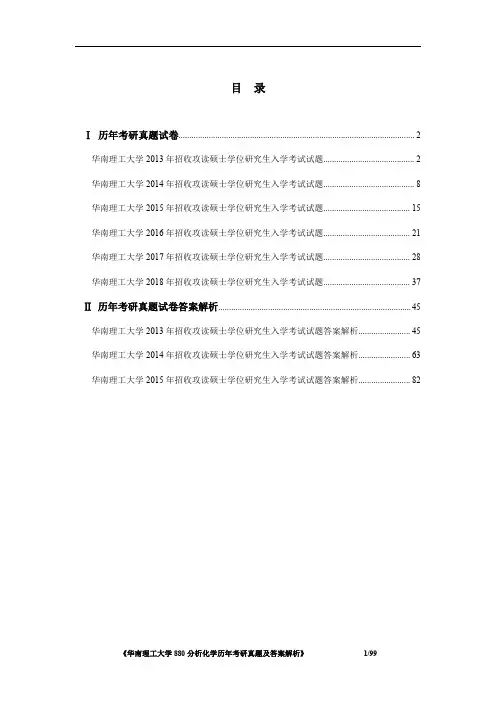
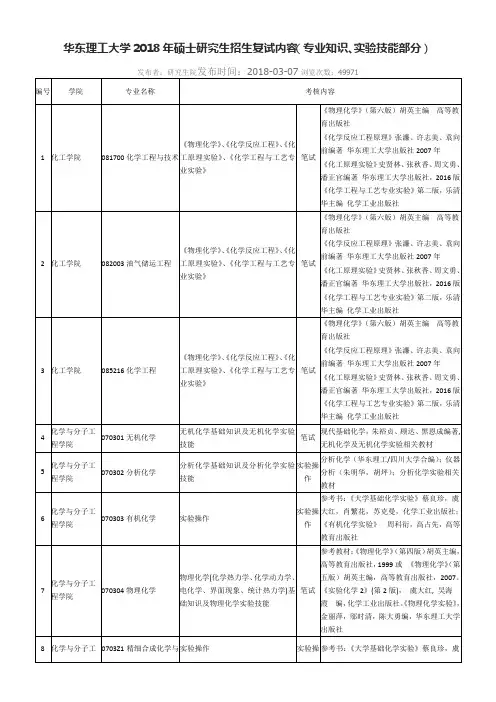
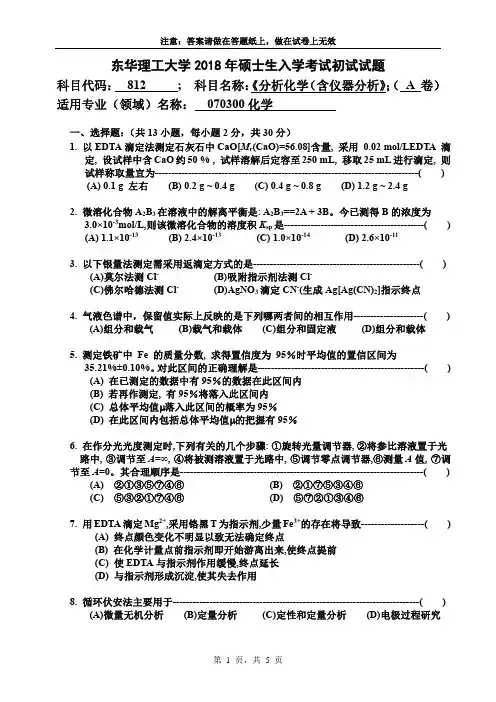
东华理工大学2018年硕士生入学考试初试试题科目代码: 812 ; 科目名称:《分析化学(含仪器分析》;( A 卷)适用专业(领域)名称: 070300化学一、选择题:(共13小题,每小题2分,共30分)1. 以EDTA滴定法测定石灰石中CaO[M r(CaO)=56.08]含量, 采用 0.02 mol/LEDTA 滴定, 设试样中含CaO约50 % , 试样溶解后定容至250 mL, 移取25 mL进行滴定, 则试样称取量宜为-------------------------------------------------------------------------------( )(A) 0.1 g 左右(B) 0.2 g ~ 0.4 g (C) 0.4 g ~ 0.8 g (D) 1.2 g ~ 2.4 g2. 微溶化合物A2B3在溶液中的解离平衡是: A2B3==2A + 3B。
今已测得B的浓度为3.0×10-3mol/L,则该微溶化合物的溶度积K sp是------------------------------------------( )(A) 1.1×10-13 (B) 2.4×10-13 (C) 1.0×10-14 (D) 2.6×10-113. 以下银量法测定需采用返滴定方式的是--------------------------------------------------( )(A)莫尔法测Cl-(B)吸附指示剂法测Cl-(C)佛尔哈德法测Cl-(D)AgNO3滴定CN-(生成Ag[Ag(CN)2]指示终点4. 气液色谱中,保留值实际上反映的是下列哪两者间的相互作用---------------------( )(A)组分和载气(B)载气和载体(C)组分和固定液(D)组分和载体5. 测定铁矿中 Fe 的质量分数, 求得置信度为 95%时平均值的置信区间为35.21%±0.10%。
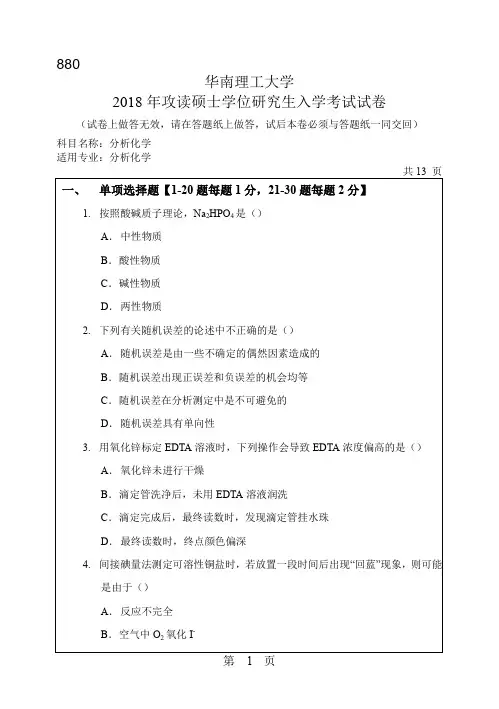
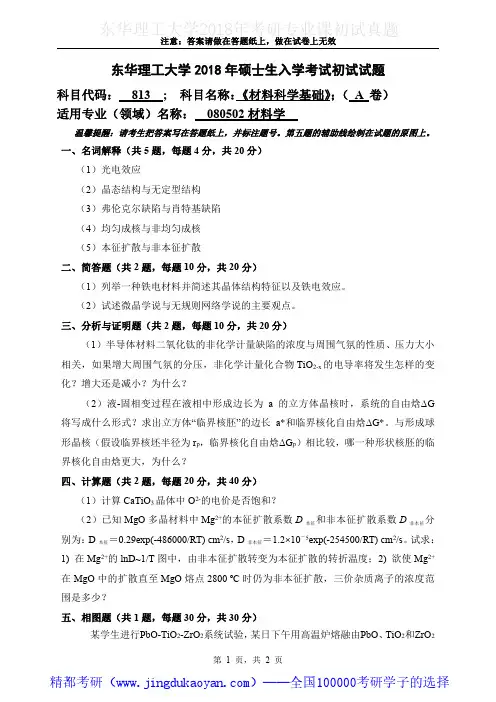
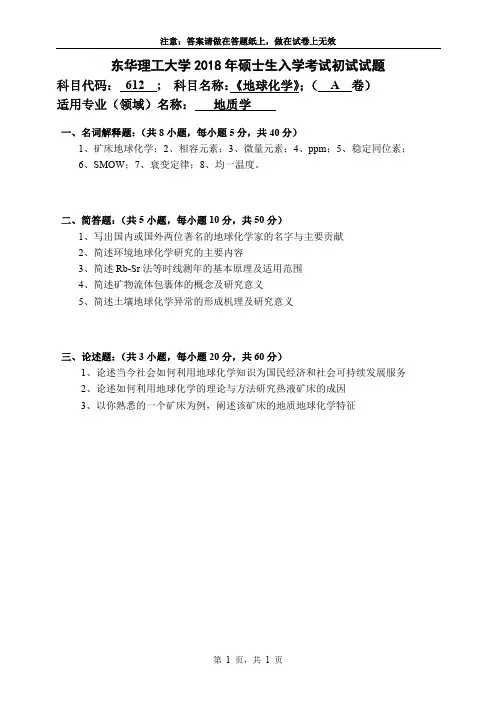
注意:答案请做在答题纸上,做在试卷上无效
东华理工大学2018年硕士生入学考试初试试题
科目代码:612 ; 科目名称:《地球化学》;( A 卷)
适用专业(领域)名称:地质学
一、名词解释题:(共8小题,每小题5分,共40分)
1、矿床地球化学;
2、相容元素;
3、微量元素;
4、ppm;
5、稳定同位素;
6、SMOW;
7、衰变定律;
8、均一温度。
二、简答题:(共5小题,每小题10分,共50分)
1、写出国内或国外两位著名的地球化学家的名字与主要贡献
2、简述环境地球化学研究的主要内容
3、简述Rb-Sr法等时线测年的基本原理及适用范围
4、简述矿物流体包裹体的概念及研究意义
5、简述土壤地球化学异常的形成机理及研究意义
三、论述题:(共3小题,每小题20分,共60分)
1、论述当今社会如何利用地球化学知识为国民经济和社会可持续发展服务
2、论述如何利用地球化学的理论与方法研究热液矿床的成因
3、以你熟悉的一个矿床为例,阐述该矿床的地质地球化学特征
第 1 页,共 1 页。
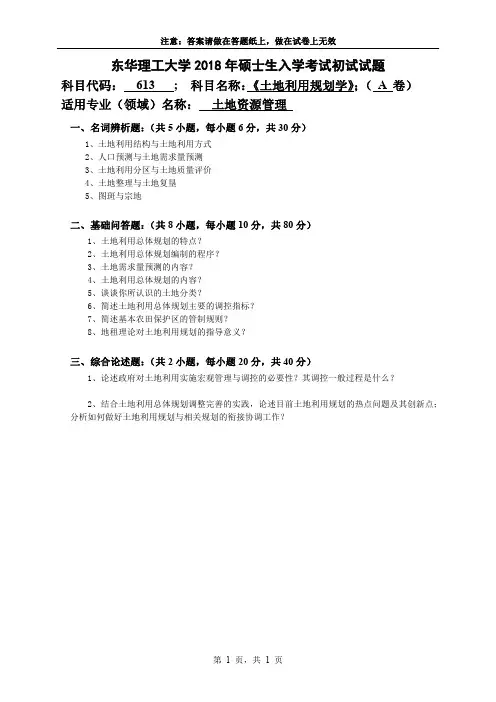
注意:答案请做在答题纸上,做在试卷上无效
东华理工大学2018年硕士生入学考试初试试题
科目代码:613;科目名称:《土地利用规划学》;(A卷)
适用专业(领域)名称:土地资源管理
一、名词辨析题:(共5小题,每小题6分,共30分)
1、土地利用结构与土地利用方式
2、人口预测与土地需求量预测
3、土地利用分区与土地质量评价
4、土地整理与土地复垦
5、图斑与宗地
二、基础问答题:(共8小题,每小题10分,共80分)
1、土地利用总体规划的特点?
2、土地利用总体规划编制的程序?
3、土地需求量预测的内容?
4、土地利用总体规划的内容?
5、谈谈你所认识的土地分类?
6、简述土地利用总体规划主要的调控指标?
7、简述基本农田保护区的管制规则?
8、地租理论对土地利用规划的指导意义?
三、综合论述题:(共2小题,每小题20分,共40分)
1、论述政府对土地利用实施宏观管理与调控的必要性?其调控一般过程是什么?
2、结合土地利用总体规划调整完善的实践,论述目前土地利用规划的热点问题及其创新点;并
分析如何做好土地利用规划与相关规划的衔接协调工作?
第1页,共1页。
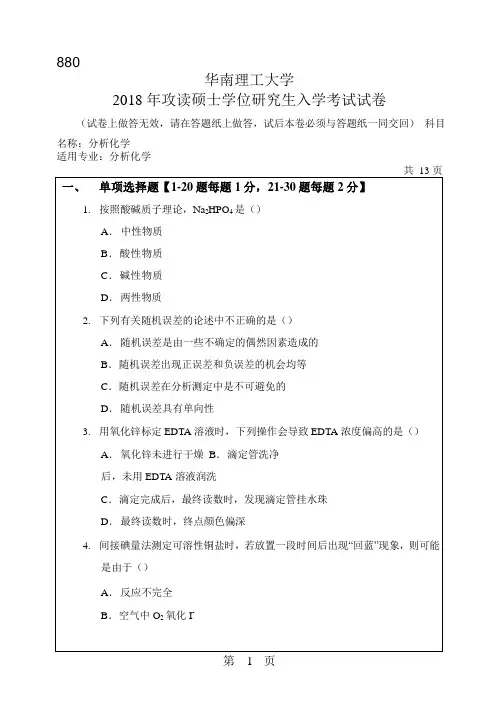
880华南理工大学2018 年攻读硕士学位研究生入学考试试卷(试卷上做答无效,请在答题纸上做答,试后本卷必须与答题纸一同交回)科目名称:分析化学适用专业:分析化学共13 页一、单项选择题【1-20 题每题1 分,21-30 题每题2 分】1. 按照酸碱质子理论,Na2HPO4是()A.中性物质B.酸性物质C.碱性物质D.两性物质2. 下列有关随机误差的论述中不正确的是()A.随机误差是由一些不确定的偶然因素造成的B.随机误差出现正误差和负误差的机会均等C.随机误差在分析测定中是不可避免的D.随机误差具有单向性3. 用氧化锌标定EDTA 溶液时,下列操作会导致EDTA 浓度偏高的是()A.氧化锌未进行干燥B.滴定管洗净后,未用EDTA 溶液润洗C.滴定完成后,最终读数时,发现滴定管挂水珠D.最终读数时,终点颜色偏深4. 间接碘量法测定可溶性铜盐时,若放置一段时间后出现“回蓝”现象,则可能是由于()A.反应不完全B.空气中O2氧化I-C.氧化还原反应速度慢D.淀粉指示剂变质5. 摩尔法测定Cl-,控制溶液pH=4.0,其滴定终点将()A.不受影响B.提前到达C.推迟到达D.刚好等于化学计量点6. 用高锰酸钾法测定铁,一般使用硫酸而不是盐酸调节酸度,其主要原因是()A.盐酸有挥发性B.硫酸可以起催化作用C.盐酸强度不够D.Cl-可能与KMnO4 反应7. AgCl 在0.01mol/L HCl 中溶解度比在纯水中小,是()的结果。
A.共同离子效应B.酸效应C.盐效应D.配位效应8. 氧化还原反应的条件平衡常数与下列哪个因素无关()A.氧化剂与还原剂的初始浓度B.氧化剂与还原剂的副反应系数C.两个半反应电对的标准电位D.反应中两个电对的电子转移数9. pH 玻璃电极使用前必须在水中浸泡,其主要目的是()A.清洗电极B.活化电极C.校正电极D.清除吸附杂质10. 用氟离子选择性电极测定水中(含有微量的Fe3+、Al3+、Ca2+、Cl-)的氟离子时,应选用的离子强度调节缓冲溶液为()A.0.1 mol/L KNO3B.0.1 mol/L NaOHC.0.1 mol/L 柠檬酸钠(pH 调至5-6)D.0.1 mol/L NaAc(pH 调至5-6)11. 在正相色谱柱上分离含物质1,2,3 的混合物,其极性大小依次为:物质1>物质2>物质3,其保留时间t 的相对大小依次为()A.t1>t2>t3B.t1<t2<t3C.t2>t1>t3D.t2<t1<t312. 常用于评价色谱分离条件选择是否适宜的参数是()A.理论塔板数B.塔板高度C.分离度D.死时间13. 在符合朗伯-比尔定律的范围内,有色物质的浓度、最大吸收波长、吸光度三者的关系是()A.增加、增加、增加B.减小、不变、减小C.减小、增加、增加D.增加、不变、减小14. 下列仪器分析方法中适宜采用内标法定量的是()A. 紫外-可见分光光度法B. 原子吸收光谱法C. 色谱分析法D. 极谱分析法15. 用0.10 mol/L NaOH 滴定同浓度HAc(pKa=4.74)的pH 突跃范围为7.7~9.7。
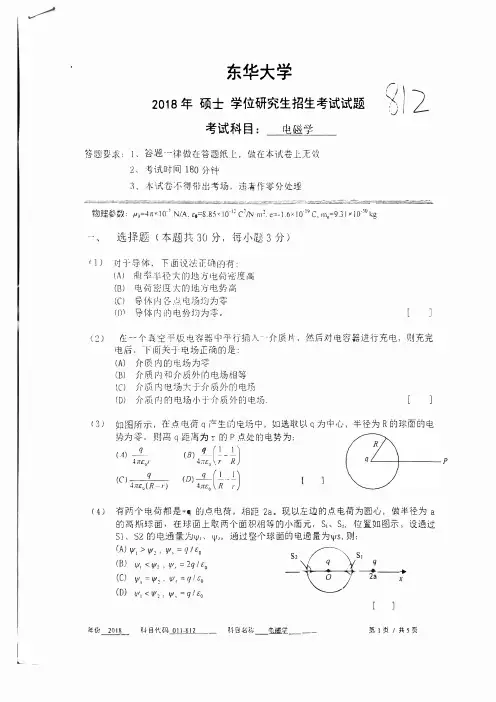
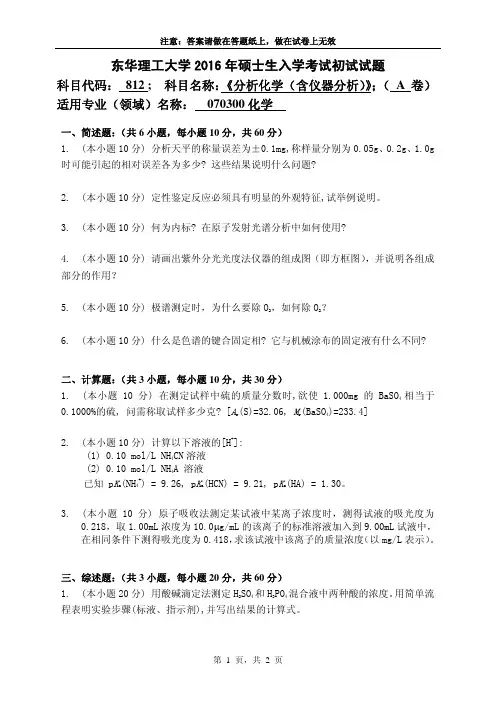
注意:答案请做在答题纸上,做在试卷上无效第 1 页,共 2 页 东华理工大学2016年硕士生入学考试初试试题科目代码: 812 ; 科目名称:《分析化学(含仪器分析)》;( A 卷) 适用专业(领域)名称: 070300化学一、简述题:(共6小题,每小题10分,共60分)1. (本小题10分) 分析天平的称量误差为±0.1mg,称样量分别为0.05g、0.2g、1.0g 时可能引起的相对误差各为多少? 这些结果说明什么问题?2. (本小题10分) 定性鉴定反应必须具有明显的外观特征,试举例说明。
3. (本小题10分) 何为内标? 在原子发射光谱分析中如何使用?4. (本小题10分) 请画出紫外分光光度法仪器的组成图(即方框图),并说明各组成部分的作用?5. (本小题10分) 极谱测定时,为什么要除O 2,如何除O 2?6. (本小题10分) 什么是色谱的键合固定相? 它与机械涂布的固定液有什么不同?二、计算题:(共3小题,每小题10分,共30分)1. (本小题10分) 在测定试样中硫的质量分数时,欲使 1.000mg 的BaSO 4相当于0.1000%的硫, 问需称取试样多少克? [A r (S)=32.06, M r (BaSO 4)=233.4]2. (本小题10分) 计算以下溶液的[H +]:(1) 0.10 mol/L NH 4CN 溶液(2) 0.10 mol/L NH 4A 溶液已知 p K a (NH 4+) = 9.26, p K a (HCN) = 9.21, p K a (HA) = 1.30。
3. (本小题10分) 原子吸收法测定某试液中某离子浓度时,测得试液的吸光度为0.218,取1.00mL 浓度为10.0μg/mL 的该离子的标准溶液加入到9.00mL 试液中,在相同条件下测得吸光度为0.418,求该试液中该离子的质量浓度(以mg/L 表示)。
三、综述题:(共3小题,每小题20分,共60分)1. (本小题20分) 用酸碱滴定法测定H 2SO 4和H 3PO 4混合液中两种酸的浓度。
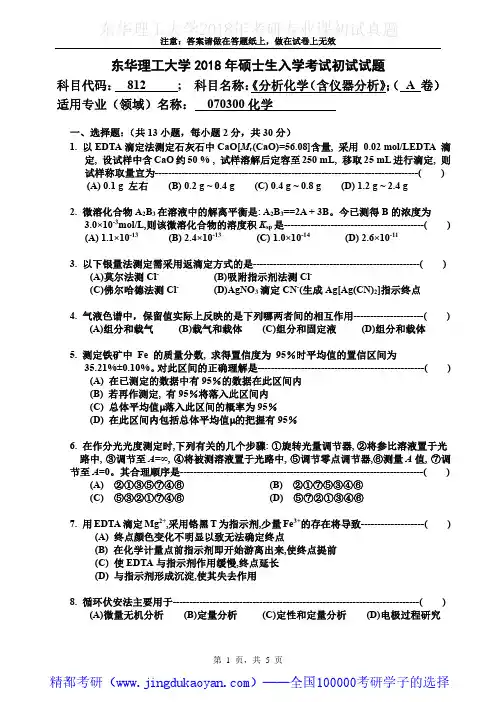
880华南理工大学2008年攻读硕士学位研究生入学考试试卷(试卷上做答无效,请在答题纸上做答,试后本卷必须与答题纸一同交回) 科目名称:分析化学适用专业:分析化学 共 7 页一.单项选择题(共20题,每空1.5分,共计30分)1. 甲乙丙丁四人同时分析一矿物中的含硫量,取样均为3.5 g ,下列哪份报告的数据合理( )A. 甲:0.04%B. 乙:0.042%C. 丙:0.0421%D. 丁:0.04211%2. 消除分析方法中存在的系统误差,可以采用的方法是( )A. 增大试样称量质量B. 用两组测量数据对照C. 增加测定次数D. 进行仪器校准3. 浓度为c HCl (mol ⋅L -1)的HCl 和c NaOH (mol ⋅L -1)的NaOH 混合溶液的质子平衡方程为( )A.B. [][]HCl c OH H +=−+[][]HCl NaOH c OH c H +=+−+C. [][]−+=+OH c H NaOHD. [][]NaOH HCl c c OH H ++=−+4. 某二元弱酸H 2B 的pKa 1和pKa 2为3.00和7.00,pH=3.00的0.20 mol ⋅L -1H 2B 溶液中,HB -的平衡浓度为( )A. 0.15 mol ⋅L -1B. 0.050 mol ⋅L -1C. 0.10 mol ⋅L -1D. 0.025 mol ⋅L -15. 以H 2C 2O 4⋅2H 2O 作基准物质,用来标定NaOH 溶液的浓度,现因保存不当,草酸失去了部分结晶水,若用此草酸标定NaOH 溶液,NaOH 的浓度将( )A. 偏低B. 偏高C. 无影响D. 不能确定6. 以EDTA 为滴定剂,下列叙述中哪项是错误的( )A. 在酸度较高的溶液中,可能形成MHY 络合物;B. 在碱度较高的溶液中,可能形成MOHY 络合物;C. 不论形成MHY 或MOHY 均有利于滴定反应;D. 不论形成MHY 或MOHY 均不有利滴定反应7. 用EDTA 法测定Fe 3+、Al 3+、Ca 2+、Mg 2+混合溶液中的Ca 2+、Mg 2+的含量,如果Fe 3+、Al 3+的含量较大,通常采取什么方法消除其干扰( )A. 沉淀分离法B. 控制酸度法C. 络合掩蔽法D. 溶剂萃取法8. 在含有Fe 3+和Fe 2+的溶液中,加入下列何种溶液,Fe 3+/Fe 2+电对的电位将升高(不考虑离子强度影响)( )A. 邻二氮菲B. HClC. H 3PO 4D. H 2SO 49. 已知1 mol.l -1 H 2SO 4溶液中,,,在此条件下用KMnO V 45.1'Mn /MnO 24=ϕθ+−V 68.0'Fe /Fe 23=ϕθ++4标准溶液滴定Fe 2+,其化学计量点的电位为( )A. 0.38 VB. 0.73 VC. 0.89 VD. 1.32 V10. 佛尔哈德法测定时的介质条件为( )A. 稀硝酸介质B. 弱酸性或中性C. 和指示剂的PKa 有关D. 没有什么限制11. 在以下各类滴定中,当滴定剂与被滴物质均增大10倍时,滴定突跃范围增大最多的是( )A. NaOH 滴定HAcB. EDTA 滴定Ca 2+C. K 2Cr 2O 7滴定Fe 2+D. AgNO 3滴定Cl -12. 在沉淀过程中,与待测离子半径相近的杂质离子常与待测离子一起与沉淀剂形成( )。
东华理工大学2018年硕士生入学考试初试试题科目代码: 840 ; 科目名称:《综合英语》;( A 卷)适用专业(领域)名称:学科教学(英语)Part I Reading Comprehension (50%,2.5*20)In this section there are four passages followed by questions or unfinished statements, each with four suggested answers marked A, B, C and D. Choose the one that you think is the best answer.Text AThe bag is one of the most simple and useful things in the world. It is a container made of paper or cloth. It has given the world many strange expressions that are not very simple. Some of them are used in the United States today.One is “bagman”. It describes a go-between. The go-between sees to it that money is passed — often illegally — from one person to another. Another widely-used expression is to “let the cat out of the bag”. It is used when someone tells something that was supposed to be secret. No one can explain how the cat got into the bag. But there is an old story about it.Long ago tradesmen sold things in large cloth bags. One day a woman asked for a pig. The tradesman held up a cloth bag with something moving inside it. He said it was a live pig. The woman asked to see it. When the dishonest tradesman opened the bag, out jumped a cat — not a pig. The tradesman’s secret was out. He was trying to trick her. And now everybody knew it.The phrase “to be left holding the bag” is as widely used as the expression “to let the cat out of the bag”. This expression makes the person left holding the bag responsible for an action, often a crime or misdeed. That person is the one who is punished. The others involved in the act escape. Where the expression came from is not clear. Some say that General George Washington used it during the American Revolutionary War. One of Washington’s officers, Royall Taylor, used the expression in a play about Daniel Shay’s rebellion. The play was in 1787, after Taylor helped to put down Shay’s rebellion.Shay led a thousand war veterans in an attack on a federal building in Springfield, Massachusetts. Guns were in the building. Some of the protesters were farmers who had no money to buy seed. Some had been put in prison for not paying their debts. They were menwho fought one war against the king of England, and were now prepared to fight against their own government. Most of the rebels were captured. Shay and some of the officers escaped.In his play, Taylor describes Shay as disappearing, giving others “the bag to hold”.A bag is useful in many ways. Just be careful not “to let the cat out of the bag”, or someone may leave you “holding the bag”.1. According to the passage, a bagman refers to _________________.A) a person who travels around carrying his things in a bag B) a vagrant workerC) a person who delivers or collects money for criminals D) a homeless person2. Which of the following is TRUE concerning the story about “let the cat out of the bag”?A) The tradesman wanted to play a joke with the woman.B) The woman wanted to buy a cat.C) The tradesman kept a cat in a plastic bag.D) The tradesman lied to the woman that he had a live pig in the bag.3. What can we infer from the story “to be left holding the bag”?A) The person left holding the bag was completely innocent.B) The person left holding the bag took no responsibility for committing crimes.C) Many farmers protested against the government because they couldn’t pay their debts.D) Many protesters became the scapegoats for Shay and his officers.4. What does the last sentence of this passage mean?A) A bag has many different functions.B) People should often keep secret or they will be left to take the responsibility for everything.C) People should watch out and learn to take the responsibility for their actions.D) You will have to hold the bag if you let the cat out of it.5. The best title for this passage is ________________.A) Don’t Let the Cat Out of the Bag B) To Be Left Holding a BagC) Words and Their Stories: Bag Expressions D) Bag: A Useful ContainerText BTraditional plant breeding involves crossing varieties of the same species in ways they could cross naturally.For example,disease-resistant varieties of wheat have been crossed with high-yield wheat to combine these properties.This type of natural gene exchange is safe and fairly predictable.Genetic engineering(GE)involves exchanging genes between unrelated species that cannot naturally exchange genes with each other.GE can involve the exchange of genes between vastly different species—e.g. putting scorpion toxin genes into maize or fish antifreeze genes into tomatoes.It is possible that a scorpion toxin gene,even when it is in maize DNA,will still get the organism to produce scorpion toxin, but what other effects may it have in this alien environment?We are already seeing this problem—adding human growth hormone genes to pigs certainly makes them grow—but it also gives them arthritis and makes them cross-eyed,which was entirely unpredictable.It will be obvious,for example,that the gene for human intelligence will not have the same effect if inserted into cabbage DNA as it had in human DNA, but what side-effect would it have?In other words,is GM food safe to eat?The answer is that nobody knows because long-term tests have not been carried out.Companies wanting a GM product approved in the UK or U.S. are required to provide regulatory bodies with results of their own safety tests.Monsanto’s soya beans were apparently fed to fish for ten weeks before being approved.There was no requirement for independent testing,for long-term testing,for testing on humans or testing for specific dangers to children or allergic people.The current position of the UK Government is that “There is no evidence of long-term dangers from GM foods.” In the U.S.,the American Food and Drug Administration (AFDA) is currently being prosecuted for covering up research that suggested possible risks from GM foods.6. Genetic engineering .A) involves crossing varieties of the same speciesB) is safe and fairly predictableC) is dangerous and entirely unpredictableD) covers the exchange of genes between different species7. According to the passage, which of the following statements is NOT true?A) The side-effect of adding human growth hormone to pigs is that pigs may acquire somediseases of human.B) Human intelligence gene functions differently in human DNA and in cabbage DNA.C) In the UK or U.S., a GM product cannot be approved before the results of its safetytests are provided.D) Tests show that GM foods have specific dangers to children or allergic people.8. What can we infer from the last paragraph?A) There is no evidence of long-term dangers from GM foods.B) The UK government and the U.S. government have different attitudes towards GMfoods.C) The AFDA in the U.S. was charged with concealing some research findings.D) The governments of the UK and the U.S. are protecting the GM foods.9. The possible title for the passage might be .A) Safe to Eat? B) GM Food NeedsC) Genetic Engineering D) A New Way of Breeding10. What’s the writer’s attitude towards GM food?A) Neutral. B) Positive. C) Negative. D) Indifferent. Text CFaces, like fingerprints, are unique. Did you ever wonder how it is possible for us to recognize people? Even a skilled writer probably could not describe all the features that make one face different from another. Yet a very young child-or even an animal, such as a pigeon-can learn to recognize faces. We all take this ability for granted.We also tell people apart by how they behave. When we talk about someone’s personality, we mean the ways in which he or she acts, speaks, thinks and feels that make that individual different from others.Like the human face, human personality is very complex. But describing someone’s personality in words is somewhat easier than describing his face. If you were asked to describe what a “nice face” looked like, you probably would have a difficult time doing so.But if you were asked to describe a “nice person,” you might begin to think about someone who was kind, considerate, friendly, warm, and so forth.There are many words to describe how a person thinks, feels and acts. Gordon Allport, an American psychologist, found nearly 18,000 English words characterizing differences in people’s behavior. And many of us use this information as a basis for describing, or typing, his personality. Bookworms, conservatives, military types---- people are described with such terms.People have always tried to “type” each other. Actors in early Greek drama wore masks to show the audience whether they played the villain’s or the hero’s role. In fact, the words “person” and “personality” come from the Latin persona, meaning “mask”. Today, most television and movie actors do not wear masks. But we can easily tell the “good guys” from the “bad guys” because the two types differ in appearance as well as in actions.11. The main idea of this passage is ____________.A) how to distinguish people’s facesB)how to describe people’s personalityC) how to distinguish people both inward and outwardD) how to differ good persons from bad persons12. The author is most probably a _________.A) behaviorist B) psychologist C) sociologist D) scientist13. Which of the following is NOT true?A) Different people may have different personalities.B) People differ from each other in appearance.C) People can learn to recognize faces.D) People can describe all the features of others.14. The reason why it is easier to describe a person’s personality in words than his face is that________.A) a person’s face is more complex than his personalityB) a person’s personality is easily distinguishedC) a person’s personality is very complexD) many words are available when people try to describe one’s personality15. W e learn from the passage that people classify a person into a certain type according to________.A) his way of acting and thinking B) his way of speaking and behavingC) his learning and behavior D)his physical appearance and hispersonalityText DIt is often helpful when thinking about biological processes to consider some apparently similar yet better understood non-biological process. In the case of visual perception an obvious choice would be colour photography. Since in many respects eyes resemble cameras, and percepts photographs, is it not reasonable to assume that perception is a sort of photographic process whereby samples of the external world become spontaneously and accurately reproduced somewhere inside our heads? Unfortunately, the answer must be no. The best that can be said of the photographic analogy is that it points up what perception is not. Beyond this it is superficial and misleading. Four simple experiments should make the matter plain.In the first a person is asked to match a pair of black and white discs, which are rotating at such a speed as to make them appear uniformly grey. One disc is standing in shadow, the other in bright illumination. By adjusting the ratio of black to white in one of the discs the subject tries to make it look the same as the other. The results show him to be remarkably accurate, for it seems he has made the proportion of black to white in the brightly illuminated disc almost identical with that in the disc which stood in shadow. But there is nothing photographic about his perception, for when the matched discs, still spinning, are photographed, the resulting print shows them to be quite dissimilar in appearance. The disc in shadow is obviously very much darker than the other one. What has happened? Both the camera and the person were accurate, but their criteria differed. One might say that the camera recorded things as they look, and the person things as they are. But the situation is manifestly more complex than this, for the person also recorded things as they look. He did better than the camera because he made them look as they really are. He was not misled by the differences in illumination. He showed perceptual constancy. By reason of an extremely rapid, wholly unconscious piece of computation he received a more accurate record of theexternal world than could the camera.In the second experiment a person is asked to match with a colour card the colours of two pictures in dim illumination. One is of a leaf, the other of a donkey. Both are coloured an equal shade of green. In making his match he chooses a much stronger green for the leaf than for the donkey. The leaf evidently looks greener than the donkey. The percipient makes a perceptual world compatible with his own experience. It hardly needs saying that cameras lack this versatility.In the third experiment hungry, thirsty and satiated people are asked to equalize the brightness of pictures depicting food, water and other objects unrelated to hunger or thirst. When the intensities at which they set the pictures are measured it is found that hungry people see pictures relating to food as brighter than the rest (i.e. to equalize the pictures they make the food ones less intense), and thirsty people do likewise with “drink” pictures. For the satiated group no differences are obtained between the different objects. In other words, perception serves to satisfy needs, not to enrich subjective experience. Unlike a photograph the percept is determined by more than just the stimulus.The fourth experiment is of a rather different kind. With ears plugged, their eyes beneath translucent goggles and their bodies either encased in cotton wool, or floating naked in water at body temperature, people are deprived for considerable periods of external stimulation. Contrary to what one might expect, however, such circumstances result not in a lack of perceptual experience but rather a surprising change in what is perceived. The subjects in such an experiment begin to see, feel and hear things which bear no more relationship to the immediate external world than does a dream in someone who is asleep. These people are not asleep yet their hallucinations, or so-called ‘autistic’ perceptions, may be as vivid, if not more so, than any normal percept.16. In the first paragraph, the author suggests that _______.A. colour photography is a biological processB. vision is rather like colour photographyC. vision is a sort of photographic processD. vision and colour photography are very different17. In the first experiment, it is proved that a person _______.A. makes mistakes of perception and is less accurate than a cameraB. can see more clearly than a cameraC. is more sensitive to changes in light than a cameraD. sees colours as they are in spite of changes in the light18. The second experiment shows that ________.A. people see colours according to their ideas of how things should lookB. colours look different in a dim lightC. cameras work less efficiently in a dim lightD. colours are less intense in larger objects19. What does “to equalize the brightness” (Line 1, Para. 4) mean?A. To arrange the pictures so that the equally bright ones are together.B. To change the lighting so that the pictures look equally bright.C. To describe the brightness.D. To move the pictures nearer or further away.20. The group of experiments, taken together, proves that human perception is _______.A. unreliableB. mysterious and unpredictableC. less accurate than a cameraD. related to our knowledge, experience and needsPart II Translation ( 50 Points)Section A :For this part, you are allowed 30 minutes to translate a passage from Chinese into English.(30%)1812年春,拿破仑在俄国边境屯兵60万。